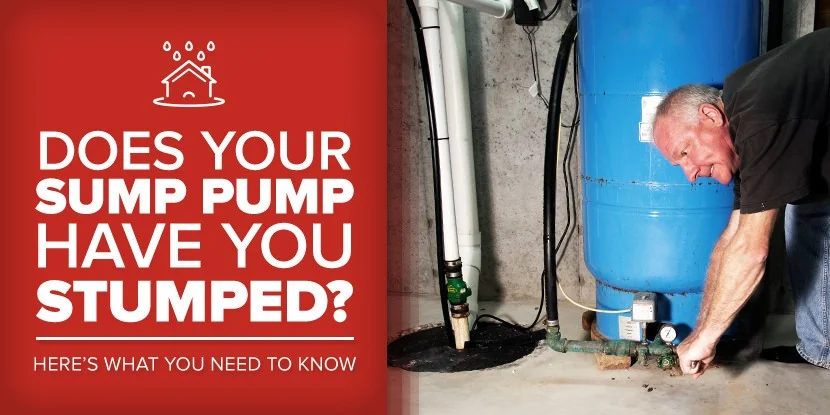
Who needs a sump pump? The answer to that question may surprise you because all homeowners should have a sump pump. You may believe that because you don’t live in a flood-prone area, you don’t need one. But in reality, any home with an underground level needs one. This includes basements, crawlspaces and cellars. Sometimes, a sump pump is necessary for roof water, too. It’s estimated that at least 60 percent of homes have problems with basement moisture.
Before deciding if you need a sump pump, you need to know more about costs and what type you need. It’s a good idea to learn more about their purpose and sump pump types, too.
Understand the Costs
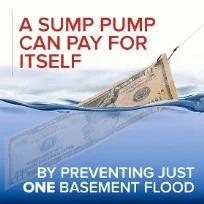
You may hesitate to install a sump pump because you think it’s big investment. Before making a decision, compare the cost of sump pump installation to the cost of cleaning up a flooded basement.
The average cost of installing a new sump pump system can range $300 to $500 dollars, according to CostHelper.com. The same site estimates the average cost of cleaning up a flooded basement can range between $500 and $1,500 dollars.
Installing a sump pump can pay for itself by preventing just one basement flood.
What Are Sump Pumps?
Sumps pumps are small pumps installed in the lowest part of your crawlspace or basement. Its purpose is to keep the area under your home dry and to prevent flooding.
How Do Sump Pumps Work?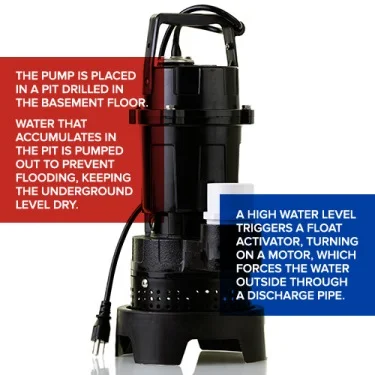
Before the sump pump is installed, a pit is constructed in the basement that the pump fits into. Water makes its way into the pit through drains or through the natural movement of water through the soil. Once inside, sump pumps work by carrying the water out of the pit to prevent flooding and keep the underground level dry.
The pumps have a float activator that is triggered by the water level. Once the water level rises, the pump is activated. A motor turns on, forcing water through a discharge pipe to the outdoors. Sump pumps have a check valve, also known as a one-way valve, which prevents water from flowing back into the home.
They run on your home’s main electrical current, so there is no need for special wiring jobs. But you should install a circuit interrupter on the unit to avoid electrocution in case of a malfunction.
The sump pump offers homeowners many benefits for the lowest home levels by:
- Preventing flooding from rainwater
- Protecting against sewage backups
- Keeping basement humidity levels low
- Reducing the risk of mold and mildew growth

Types of Sump Pumps
While all sump pumps basically perform the same job, there are different types of sump pumps: submersible and pedestal sump pumps are very common choices. Two other types of sump pumps include the floor sucker and water-powered pumps.
Submersible Sump Pumps
Submersible sump pumps run on electricity. They are installed in the ground and specifically made to work in water and have a float-activated switch. They have a sealed, oil-cooled motor that protects them from moisture and dust, making them run quieter than other types of sump pumps.
Pedestal Sump Pumps
Unlike submersible sump pumps, pedestal sump pump motors are not made to work in water. Its electric motor is located above the pump. Pedestal pumps also have a float-activated switch that is triggered by the water level. These models are noisier than the submersible types, but they are better suited for basements that need frequent water drainage. They cost less than submersible pumps.
Floor Sucker Sump Pumps
Floor sucker sump pumps are aptly named because they do not need a pit. Instead, they remove water off the floor — and even off of other surfaces, like a roof. You can choose between electric and water-powered options. And even though they can suck water off surfaces, you can still choose to use them as submersible pumps.
Water Powered Sump Pumps
As the name implies, water-powered sump pumps do not need electricity. Instead, they operate using water pressure from your home’s plumbing system. These pumps work in the same manner as electric pumps and have the same float-activated switch. One difference is that since they do not use electricity, water-powered pumps are often used as back up pumps along with electric models in case of a power failure.
Other Sump Pump Types
While submersible and pedestal sump pumps are two of the most common, there are other less common types used: ejector pumps and sewage pumps.
Ejector Pumps
While you should not install sump pumps in areas where there is gravel or debris, sometimes you have no choice. Crawlspaces are sometimes made up of pea gravel instead of concrete — and you still need a sump pump to keep it dry.
Ejector pumps are made to handle small debris. They are a bit higher priced than other types of sump pumps but are a necessity is some cases.
Ejector pumps are made of cast iron and have a larger ejector port and a different type of impeller that allows them to handle debris without harming the system.
Sewage Pumps
The use of sewage pumps is rare. They are mainly used in older homes where all the wastewater is directed to the sump pit. Homes that still use a sewage pit must also have a sewage crock with a sealed lid to prevent odors from escaping.
If you do have a rare case and need to use a sewage pump, make sure your pump can handle any solids that may enter it. Generally, water from your washing machine, shower, dishes, dishwasher, and maybe even the toilet, flows into the sump pit.
No matter which type of sump pump you have in your home, it won’t last forever. While there is no definite “life span” for sump pumps, proper maintenance and other factors play a role in how long they last. It helps to know some common reasons why sump pumps fail and what to do when sump pumps fail.
What Causes Sump Pump Failure?
Improper maintenance can eventually lead to sump pump failure. All sump pumps need cleaning and maintenance. Take the time to clean your sump pump about every 3 months. It takes a few simple steps:
- Run a vinegar solution consisting of one part vinegar to three parts water through the system to clean the pump and remove any buildup.
- Clean all air holes and vents in your system.
- If you have a battery backup system, make sure the batteries work.
Even when properly maintaining your system, several other issues can cause failure:
Power Outage: This is one of the most common reasons for sump pump failure, and it often occurs when you need your sump pumps most — during a thunderstorm with heavy rain. To prevent this, install a water-powered backup pump or have a generator on hand.
Improper Installation: Proper installation is important if you want your sump pump to work correctly. You should follow all manufacturers’ instructions if you install it yourself, and consider these important tips:
- Make sure a check valve is installed to prevent a backflow of water.
- Drill a small air relief hole in the discharge line between the check valve and pump. This prevents the pump from having to compensate for pressure in the discharge pipe.
- Do not set the sump pump in a pit containing gravel or dirt unless it’s made to handle debris. This can lead to debris entering your pump and interfering with the float arm or on/off switch.
Switch Problems: A switch problem occurs when the pump shifts from its position in the basin causing the float to be ineffective. This is a problem because the float makes the on/off switch operate smoothly. Your pump requires both the float and switch to work correctly so it can operate effectively.
Wrong Size of Sump Pump: Whether the pump you choose is too large or too small, it can lead to a shorter life span. In both situations, the life of the pump is shortened because it is forced to work too much (large) or not enough (small). To determine the size of pump you need, you should consider:
- How high the water level will need to be pumped
- How much water needs to be pumped
- The length and size of the discharge pipe
- Horsepower — a 1/3 horsepower pump is sufficient for most homes
Discharge Line Problems: If water cannot flow through the discharge pipe, your sump pump cannot work correctly. Water cannot exit the pipe if it is frozen or clogged with dirt, rock, sticks and other types of small debris.
Defective Product: While defects do not occur nearly as often as other issues, they can happen. Test the sump pump after you’ve installed it to make sure it is working properly. To test it, pour five gallons of water in the pit and make sure the sump pump turns on and the water is directed away from the house.
Old Age: While there is no set lifespan for sump pumps, and many factors play into how long the pump will last, you should consider replacing your sump pump after 10 years of use if it isn’t working properly.
Additional Sump Pump Care Tips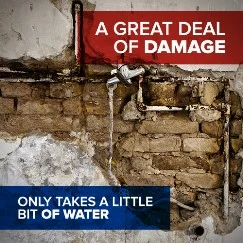
Along with proper maintenance, there are some other tips to make sure your sump pump continues to work effectively:
- Replace the batteries on the backup pump every 2 to 3 years
- When the pump is running, listen for any unusual noises.
- If you have a backup sump pump, run it periodically to make sure it is working properly.
- When testing your sump pump, go outside while it’s running and make sure water is being directed outdoors.
- Clean out the air holes in the discharge line.
- Always make sure the float switch is not restricted. If it is, the pump won’t turn on when it’s needed.
With proper sump pump maintenance, you can protect your home from water damage. It only takes a small amount of water to do a great deal of damage.
Back-Up Plans
When you install a sump pump, you should also install a backup system. This is especially important if you live in a flood-prone area or have problems with a wet basement or crawlspace. You can choose to use a water-powered pump, a battery-backup system or a generator.
To use a water-powered sump pump, your pipes must sustain moderate water pressure to operate the water-powered system. The water pressure needed is between 50 and 80 PSI. If you don’t have enough water pressure, you have another option.
You can also choose to install a battery-powered backup system. These are simple to install and run on 12-volt batteries, so you won’t have to worry about flooding should a power outage occur.
Gas- or diesel-powered generators are an option for a backup in case of a power outage. You can plug the sump pump into the generator and use it until the power is restored.
Water and battery-powered backup pumps can also be used if your sump pump fails. You can use the backup system while your primary system is undergoing repairs. The costs of installing a backup system far outweigh the price you’ll pay if your basement gets flooded. You won’t only have to deal with drying out the basement but with other problems, like mold and mildew that grow in a moist environment.
Having a backup pump is just like having insurance on your home or car. You may not use it often, but it’s there if you need it.
Sump Pump Alarms
Another way to help you protect your basement from flooding and to make sure your sump pump is working is to install a sump pump alarm. This device can alert you to problems, such as:
- The sump pump has stopped working
- Water has reached a certain dangerous level in your basement
These alarms work similarly to smoke alarms and give off a loud piercing sound if any trouble occurs.
Just like the sump pump, your alarm will need maintenance to keep it working properly. Here are some tips:
- Check the alarm regularly to make sure it is working.
- Keep the alarm free of debris.
- Check batteries often and change them when low.
- Install a backup battery system and check it regularly.
Another way to make sure the alarm system works effectively is to install it properly.
The sump pump alarm comes with complete instructions, and you should follow them carefully. Make sure you know the proper place to install the alarm. Some are designed to attach to the sump pump basin and others are to be placed in close proximity to the sump pump.
The alarm has a float sensor. You must set this slightly above your sump pump sensor level, so that the alarm can properly alert you to a failing sump pump or an excessive amount of water.
Reasons You Need a Sump Pump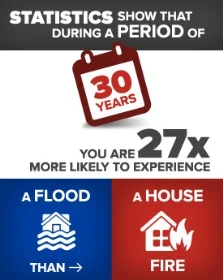
Some homeowners don’t worry about flooding because of where they live or because they’ve never had a flood. But statistics show that during a 30-year period, you are 27 times more likely to have a flood than a house fire. Here are some other flood facts to consider:
- Floods are unpredictable. While meteorologists can’t predict when they’ll occur, they can usually predict where.
- Just because a flood occurred recently doesn’t mean it won’t happen again soon.
- It’s up to the homeowner to decide how to deal with a flood.
- Just because it’s never flooded in your area doesn’t mean you aren’t at risk for floods in the future.
This is why it’s important for all homes with basements, crawlspaces and underground levels to have sump pumps. Many homeowners store valuables and other belongings in the basement and with just one flood, the items are ruined. This can be devastating if the items are irreplaceable, like picture albums, books or other keepsakes.
Dangerous Mold
Sump pumps not only help keep your belongings safe, but also help prevent the growth of mold and mildew in your basement. In some cases, the dreaded black mold can quickly grow in moist areas, spread throughout your home, and make your family sick.
Black mold can put your family at risk for:
- Breathing problems (asthma)
- Headaches
- Digestive problems
- Allergies
- Sinusitis
- Runny Nose
- Autoimmune disease
- Cancer
The best way to prevent mold growth in the basement is by not creating the moist, warm environment it needs to grow. This means keeping your basement dry.
When to Call for Help
If your sump pump isn’t working properly, and you’re not sure why, you should call for help. Mr. Rooter Plumbing of Greater Syracuse in New York can send out licensed plumbers to assist you with common problems with your sump pump.
You can go through the common reasons and do some troubleshooting, but if you’re really not sure what the issue is, it’s time to call in the professionals.
There are several reasons why it’s best to call professional when your sump pump has you stumped:
- There’s really no such thing as a minor sump pump problem.
- Any deficiency can lead to a flooded basement and costly cleanup.
- It’s best to let licensed plumbers who understand common sump pump problems inspect your system.
- Having a professional inspect and maintain your sump pump can add years to its life.
- Licensed plumbers can do the job safely because they have experience working around water and electricity.
- You can trust that your sump pump problems will be fixed because the work is guaranteed.
Our plumbers can schedule an appointment that fits your schedule, so your sump pump issues are handled right away. You can even schedule an appointment on weekends or holidays at no extra charge. Licensed plumbers can determine your sump pump problem whether it lies in the discharge pipe, the electrical wiring or other areas of the system.
Mr. Rooter of Greater Syracuse can send out a plumber who is licensed by Onondaga County for plumbing leak detection or any plumbing related project. All of our workmanship and parts are 100 percent guaranteed. Don’t let sump pump issues escalate into a flooded basement. Contact Mr. Rooter and one of our licensed plumbers can offer repair options to fit your needs.

